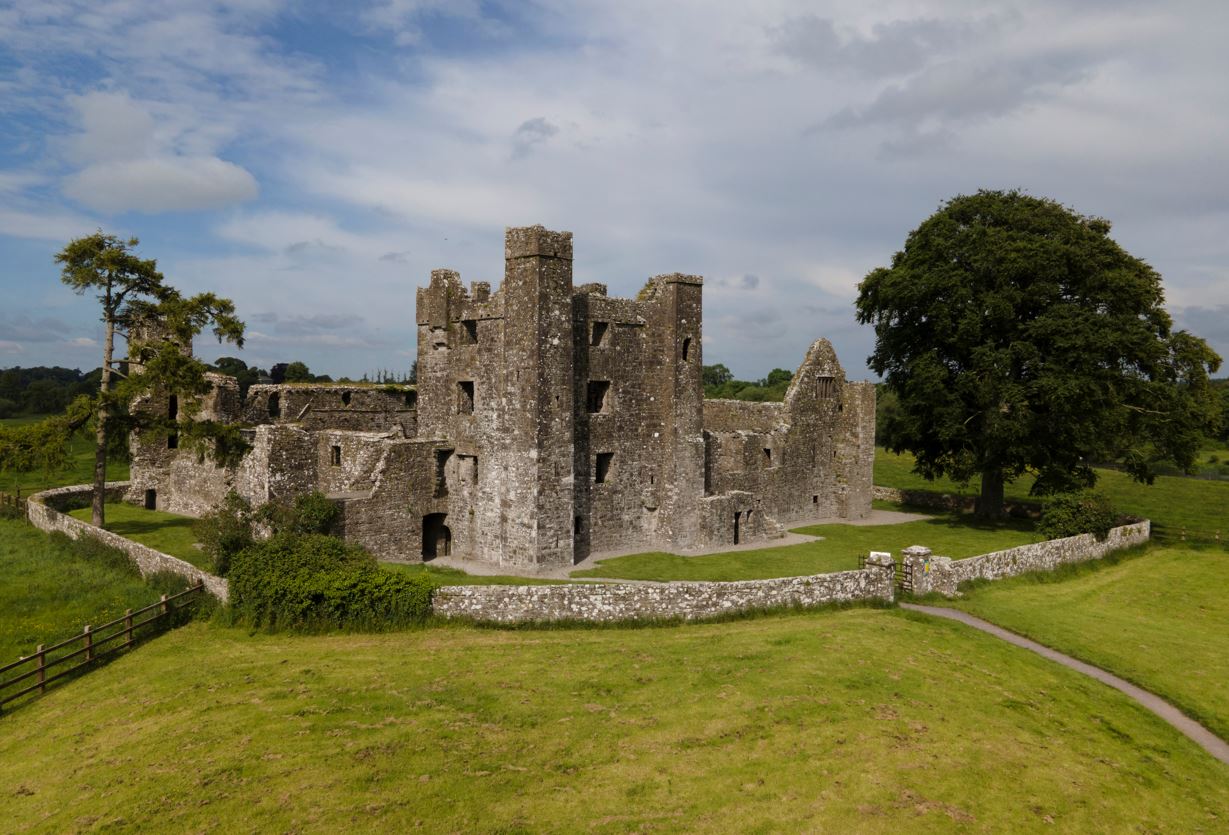1537 - the Irish Supremacy Act and dissolution of the monasteries
On 3rd November, 1534, while the rebellion of ‘Silken’ Thomas fitzGerald
was still underway in Ireland, the parliament of England passed legislation known as the first Act of Supremacy. This momentous legislation was the culmination of a series of acts used by Henry VIII to undermine the Roman Catholic church in Britain and Ireland, after failed attempts to persuade Pope Clement VII and his successor Pope Paul III, to annul his marriage to Catherine of Aragon, in his efforts to find a wife who would bear him a male heir to the throne. The act declared that the king was ‘the only supreme head [and protector of the faith] on Earth of the Church of England’. The Act of Supremacy effectively gave Henry VIII independence from Rome to pursue whatever means necessary to his fulfill his royal ambitions. Even before the act was passed, Thomas Cramner, the archbishop of Canterbury, had already consented to the annulment of Henry’s marriage to Catherine, allowing him to marry Anne Boleyn. Archbishop Cramner used the opportunity to make the initial liturgical reforms that saw the English church move towards Protestantism. The 1534 Act of Supremacy now provided the legal basis for the progression from a Catholic English church to a Protestant Church of England. This was a highly contentious event, and ‘Silken’ Thomas fitzGerald used it as an opportunity to appeal to the Pope for assistance in his revolt against Henry VIII, on the basis that by using the Act of Supremacy, the divorced king had made a heretical declaration to represent the head of the English church. Indeed, the act set in motion a sequence of events that would have the most profound impact on England’s relationship with Ireland since the arrival of the Anglo-Normans in 1169.
In 1537, the same year that ‘Silken’ Thomas was executed, the Act of Supremacy was officially enacted and extended to Ireland. With the passing of the Irish Supremacy Act, the parliament of Ireland effectively established Henry VIII as the supreme head of the Church of Ireland. However, the Protestant Reformation that had spread throughout much of central and northern Europe was slow to take hold in England, and even slower to find its way to the rest of Britain and Ireland. Throughout Europe, there had been a gradual move away from centuries of medieval feudalism towards a more modern, enlightened society influenced by the renaissance. This new movement brought changes in art, architecture, literature, philosophy, science and music. It also brought significant changes to politics and governmental structures. These changes took somewhat different forms across Europe, and the parallel religious reforms that took place were also varied. In Ireland, Protestantism was initially rejected by Gaelic and Anglo-Irish alike, and its introduction was heavily dependent on new English settlers. Nonetheless, while the majority in Ireland were reluctant to embrace Protestantism, the official State rejection of Catholicism brought some fundamental changes. One of the fall outs from the Act of Supremacy, by recognising the king of England as the head of the English church, was that much of the taxes collected by the church, known as tithes, were transferred to the crown instead of the pope. The extension of the Act of Supremacy to Ireland in 1537 brought these changes to Ireland also. In parallel to these taxation modifications, there were other more profound changes that quite literally transformed the Irish landscape. This was the dissolution of the monasteries, those late medieval institutions that had dominated the urban and rural landscape of Ireland and Britain since the 12th century.
Immediately after the Act of Supremacy was passed in 1534, and even before it was extended to Ireland in 1537, this new legislation prompted an audit of religious houses across England, Wales and Ireland in 1535. Known as Valor Ecclesiasticus, or church valuation, the purpose of the audit was to assess the value of church property and revenues on the premise of calculating a new annual taxation on the church – a tax that the crown now claimed. The heads of all the monasteries, as well as colleges and hospitals (which were all run by religious orders) were ordered to give sworn testimony before local commissioners empowered to document their estates and revenues.
In March 1536, the English parliament passed legislation that forced the closure of any monastery that the commissioners deemed worth less that £200 a year. The heads of the monastery were offered a pension, while all other residents, both clerics and lay, were forced to leave. In Ireland, among the first casualties was the Cistercian abbey at Bective, Co. Meath, which was closed in May 1536. The last abbot of Bective, John English, was granted a pension of £15, on condition that he surrendered the abbey and its estates. A year later, it was discovered that when he left, the crafty abbot had taken away goods to the value of £35, more than twice his pension. In December 1537, the former monastic estates and the abbey buildings at Bective, including the church, were leased to Thomas Agard, an English civil servant recently posted to Ireland by Thomas Cromwell. Within a few years he had demolished much of the church and converted the buildings around the old cloister into a mansion. Agard’s granddaughter, Clare, married Anthony Coclough, another English civil servant, who took a lease out on Tintern Abbey in 1562, also one of the Cistercian abbeys closed during this early wave of monastic dissolution. Today, the remains of the Tudor mansions constructed within the old Cistercian abbeys can still be seen at Bective and Tintern.
The writing was on the wall for the large monasteries too, and in 1539 the Act for the Dissolution of the Greater Monasteries was passed. This effectively brought the closure of all the monastic houses, not just in England in Wales, but across Ireland too. Mellifont Abbey, the first Cistercian monastery in Ireland, founded by St Malachy
in 1142, was closed in July 1539. It was subsequently acquired by another English man, Henry Moore, who was married to Mary Agard, granddaughter of Thomas Agard who only a few years earlier had acquired Bective Abbey nearby. Not all who benefited were ‘new’ English. Thomas Cusack, a high ranking Irish-born official, had been on the commission appointed to oversee the dissolution of the religious orders. In return, he was granted the convent of Lismullen near Navan, Co. Meath, where, ironically, his sister Mary was prioress and forced into retirement.
By the 1530s, there were some 400 religious houses across the towns and rural countryside of Ireland. Indeed, relative to its population, Ireland had a larger number of monasteries than England or Wales. Furthermore, in the predominantly Gaelic area of the country, many friaries were still flourishing, and had only recently seen ambitious programmes of refurbishment. As late as 1508, a new Franciscan friary was founded at Creevelea near Dromahair, Co. Leitrim. In these areas, the religious houses were still very much a relevant part of society, more so than in much of England and Wales. Not for the first or last time, an Irish solution was found to an English problem. As these monastic houses were located outside the area of effective English jurisdiction, there was no real prospect of granting them to new English officials, at least not for the time being. Therefore, the pragmatic decision was taken to grant these monasteries and their estates to the local Gaelic or Anglo-Irish chiefs. As these leading families were virtually all Catholic, and with little or no impact of the Protestant reformation in these areas, the closure of the monasteries here was slow. For example, the Franciscan friary at Quin, Co. Clare, was officially dissolved in 1541, and subsequently granted to the local O’Brien chief, who simply allowed the friars to continue to reside at the friary. Also in Munster, the Franciscan friary at Askeaton, Co. Limerick, was protected from closure by their powerful patrons, the fitzGerald earls of Desmond. A provincial chapter was convened here by the Irish Franciscans in 1564, but the closure of the friary was inevitable some years later, during the Desmond Rebellion.
However, in the southern and eastern parts of Ireland that were in the firm control of the English government, the closures were swift. In Waterford, the Franciscan Friary where Richard II
stayed in 1395, the church was converted into a hospital shortly after it was closed in 1540. Known as the Holy Ghost Hospital, it occupied a new floor created in the upper part of the friary nave, while the ground floor of the church became a burial place for the townspeople. In Dublin, all the monastic institutions were closed, but the citizens took exception to the proposed closure of Christ Church, home to the Augustinian Priory of the Holy Trinity, where
Strongbow
was buried in 1176, where
Lambert Simnel
had been crowned king of England in 1487 and where his sponsor,
Gerald fitzGerald, the Great earl of Kildare, was buried in 1513. In July 1537, George Browne, an English Augustinian friar arrived in Dublin to take up office as archbishop, to replace John Alen who had been murdered during the rebellion of ‘Silken’ Thomas in 1534. In a classic example of poacher turned gamekeeper, Archbishop Browne led the reformation in Dublin, and had the relics removed, including a fragment of the True Cross and the
baculus Ihesu, or staff of Jesus, which was traditionally said to have been a gift from an angel to St Patrick. In fact, archbishop Browne was one of the commissioners appointed by the crown to oversee the closure of the religious houses in Ireland. In 1539, the commissioners, including Browne, made a swift tour of the monasteries in north Leinster, meeting little resistance as they closed one after another. However, in December that year, when they arrived back in Dublin, the commissioners met with significant resistance from the local citizens regarding the closure of the Augustinian priory at Christ Church. At the last minute, a deal was struck, whereby Christ Church was promoted to cathedral status, which was justified on the grounds that it had been first established as a cathedral when it was founded by
Sitriuc Silkenbeard
over 500 years earlier. The prior would become the dean and the friars became the canons of the cathedral’s chapter (governing body). The reform of the church, whereby it moved away from the medieval organisation to a modern one that we would be more familiar with today, was well on its way. In truth, such structural reforms within the church were happening across Europe, but because of Ireland’s relationship with England, these changes were spearheaded here by a Protestant Reformation. As we shall see, in parallel to these religious changes, there were political and governmental restructurings also.


